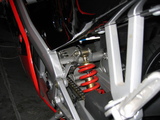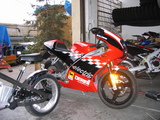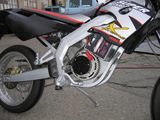
Electric GPR review Originally written January, 2006
You can see all the pictures I took on this subject in the gallery. I had been drooling over pictures of the electric GPR on Electric Motorsports' web page for a year or two, and I finally had a chance to see one in person: Over Christmas 2005, I would be in the Bay Area, in California, and my schedule would just work to take a day for myself and visit the eGPR works. On the trip down to California, I called Todd to arrange my appointment to see the bikes. He put me off, saying I should call back at noon on the Monday after Christmas to arrange the exact time and get directions.
Fortunately, Monday dawned sunny, and although it grew overcast as the day progressed, it didn't start raining again. I made arrangements with Todd Kollin, the owner of Electric Motorsport, to meet with him at 2 pm. I arrived to find that my destination was in the middle of a fairly industrial area. It was also difficult to find, but I did eventually find my way into the small warehouse space. Electric Motorsport the company is based out of a small warehouse in a larger warehouse building. It's stuffed with electric scooters, electric motorcycles, tools, parts, and art. Prominent in the space were paintings and sculpture; I didn't think to ask who the artist was.
In terms of appearance, the Electric GPR is nearly identical to its gas-powered brother. Ignoring the large "ELECTRIC" decal on the side, one of the only obviously visual differences is the lack of a tailpipe. Otherwise, an electric GPR and a gas GPR look quite similar.
In a "stock" bike (as much as that term can be used with a completely customized electric motorcycle), the tachometer in the dash is removed. In its place is a large LED display showing the battery voltage in both numerical and bargraph form. The bike I actually saw and rode was a one-off race bike, used as a pace bike for Olympic cyclists as they ride around the velodrome. It was missing the voltmeter display. Another obvious difference with this bike was that it only had 4 batteries (for a total of 48V -- the voltage strongly affects the bike's top speed). The batteries were arranged such that they could be quickly removed and replaced with a fresh set, for racing duty. The motorcycle also had no onboard charger, which is a difference from the road-ready bikes.
Eventually, the moment of truth arrived, and I put on my riding gear as Todd rolled the bike out. He explained that this bike, the race-spec GPR, was equipped with a 400 amp controller, which was set to 80% output, or 320A. This is very close to the regenerating controller, which tops out at 325A. I'm particularly interested in the regenerating controller, since it would increase the range of the bike by a noticeable amount. Quick introduction out of the way, I rode the bike around the parking lot a few times before taking it (sans headlight, signal lights, horn, etc. and thus definitely not road-legal) onto the city streets. Initial tests revealed power about equivalent to a 150 or 200cc gas motorcycle. Nothing thrilling, but definitely better than the 50cc scooter motor which originally powered the bike. Confident that I would be happy on the street (missing signals aside), I rolled out. The acceleration was less than that of the Ninja 250, but still enough to keep up with aggressive traffic. The GPR topped out just over 50 MPH indicated on the speedometer. An interesting thing I noticed was that when I rolled off the throttle to slow down from higher speed, the bike required nearly full throttle to pick up speed again. It's different from a gas motor, which just requires a little bit of throttle to go from deceleration to acceleration, but more throttle to accelerate with any authority. I found that I was fairly comfortable with how the bike performed, although it was obvious that it wouldn't win any speed contests. I wouldn't want to try it on a high-speed road, since it was clearly running flat-out as I neared 50 MPH. Todd told me at one point that most bikes are set up with a 650A controller, which is enough to propel the bike forward at about 400cc performance level. This would be more than enough, although it decreases range, and doesn't have any effect on top speed. I got the GPR back to the warehouse without any legal intervention (although I encountered three different police cruisers in my 5 minute drive). I was happy enough with it, but I didn't have the feeling it would be suitable for the riding I need to do.
Todd told me that it had a 650A controller, which he'd set to 530A so I wouldn't get into too much trouble. The thought of getting myself into trouble on an electric motorcycle was intriguing. This one had full lights and all, so I was much more comfortable having it on the streets. I pulled away from the Electric Motorsports compound, and found myself wondering what the big deal was. The SM was a little bit more powerful than the GPR, but it was a very small difference, and hardly worth any concerns about getting me into trouble. I quickly came back, convinced that if I were to get one of the two bikes, it would be the GPR, just for the riding position. The SM was fine, but I was a bit happier with the GPR's ergonomics. Todd was surprised when I said that the bike didn't seem much more powerful. He got on and rode it around the parking lot a few times. He came back and said, "yeah, that's not a 520A controller." The controller in the bike was originally labeled as a 500A controller, but that had been crossed out and replaced with the code for a 650A. We theorized that whoever updated the code had done so in error.
We chatted some more before he had to take off for a previously-scheduled engagement. I bade him farewell, and returned to my borrowed car to ponder what I'd just learned.
However, cost is a factor. $7000+ for a motorcycle is too much to spend for such a limited vehicle, for me. I think for someone else in my position, but who had a stronger ideological committment to electric vehicles, or more money available for the spending, it would be a good choice. The remaining questions in my mind are pretty practically oriented:
Knowing as much as I do about electric vehicles (which is to say, "Just enough to get myself in trouble"), I can speculate on some of these questions. The reliability will probably be very good. Mostly because there's very little to break, and of the things which can break, I'm comfortable repairing most of them. Batteries are a tough question for me, but it sounds like a typical set of lead-acid batteries in an electric vehicle last 3 years in normal use. Range is an open question, but the answer is definitely lower than what Electric Motorsport claims. I'm heavy, and I ride up a bunch of hills every day. Both of these things contribute to me getting terrible gas mileage on normal motorcycles, and will equally contribute to poor range on an electric bike. The electricity cost is answered with a bit of research. It appears that many EVs (cars, usually) spend on the order of 3-5 cents per mile. According to the latest stats on my Ninja 250 (as of January 2007), I'm spending 5 cents per mile on gasoline. However, I'm also spending $15 every 3000 miles for an oil change, and devoting hours of maintenance every couple of months to work which isn't necessary on an electric bike. I also suspect that a lightweight bike like the eGPR will see a "fuel" cost of around 1 cent per mile, simply due to the lighter weight. I don't think I'll be spending my $7000 on an eGPR just yet. However, one way or another, I think I will have an electric motorcycle in my future. Copyright 2007 by Ian Johnston. Questions? Please mail me at reaper at obairlann dot net. |








